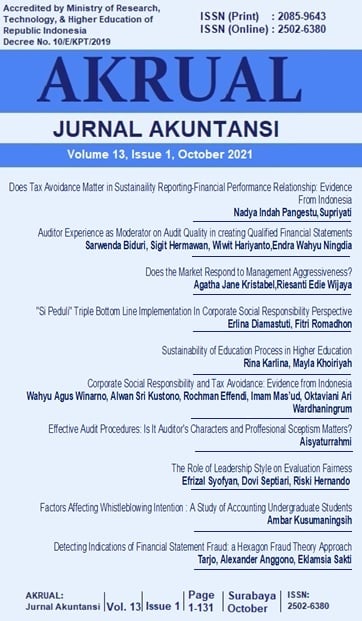Detecting Indications of Financial Statement Fraud: a Hexagon Fraud Theory Approach
DOI:
https://doi.org/10.26740/jaj.v13n1.p119-131Keywords:
hexagon fraud theory, Beneish M-Score model, stimulus, capability, collusion, opportunity, rationalization, egoAbstract
This study emphasizes on examining the fraud hexagon theory referring to signs of fraud of financial statements, which employs all manufacturing companies listed in the IDX (Indonesia Stock Exchange). However, total selected sample are 153 of the manufacturing industry. The companies are categorized into indicated and not indicated committing fraud in the 2010-2018 period by applying the Beneish M-Score. The findings demonstrated that financial stability, the financial targets, the external pressures, the nature of industry, and CEO duality can be applied to predict fraud of financial statements. Meanwhile, personal financial needs, ineffective monitoring, quality of external auditors, auditor turnover, director turnover, and marginal costs cannot indicate occurrence of the fraud of financial statement. The findings conclude that pressure, ego, and opportunity significantly affect the financial statement fraud. Future research are suggested to consider different proxies for fraudulent financial statements; hence, the accuracy of the proxies can be compared with this study. Moreover, adding other proxies of conspiracy such as bonuses received by managers will be beneficial.
References
Aprillia, A., Cicilia, O., Pertiwi Sergius, R., 2015. The Effectiveness Of Fraud Triangle On Detecting Fraudulent Financial Statement: Using Beneish Model And The Case Of Special Companies. JRAK 3, 786. https://doi.org/10.17509/jrak.v3i3.6621
Cressey, D.R., 1950. The Criminal Violation of Financial Trust. American Sociological Review 15, 738. https://doi.org/10.2307/2086606
Crowe, Horwarth. 2011. The Mind Behind The Fraudsters Crime: Key Behavioral ad Eviromental Element. Crowe Horwarth International. USA
Imam, Ghozali. 2011. Multivariate Analysis Application with IBM SPSS 19 Program. Semarang: Diponegoro University Publishing Board
Rahmatika, D.N., Kartikasari, M.D., Dewi Indriasih, D., Sari, I.A., Mulia, A., 2019. Detection of Fraudulent Financial Statement; Can Perspective of Fraud Diamond Theory be applied to Property, Real Estate, and Building Construction Companies in Indonesia? EJBMR 4. https://doi.org/10.24018/ejbmr.2019.4.6.139
Skousen, C. J., Smith, K. R., & Wright, C. J. (2009). Detecting and Predicting Financial Statement Fraud: The Effectiveness of The Fraud Triangle and SAS No. 99. In Corporate Governance and Firm Performance(Vol. 32). https://doi.org/10.1108/S1569-3732(2011)0000014001
Triyanto, D.N., 2019. Fraudulence Financial Statements Analysis using Pentagon Fraud Approach. JAAB 2, 26. https://doi.org/10.24198/jaab.v2i2.22641
Utami, E.R., Pusparini, N.O., 2019. The Analysis Of Fraud Pentagon Theory And Financial Distress For Detecting Fraudulent Financial Reporting In Banking Sector In Indonesia (Empirical Study Of Listed Banking Companies On Indonesia Stock Exchange In 2012-2017), in: Proceedings of the 5th International Conference on Accounting and Finance (ICAF 2019). Presented at the Proceedings of the 5th International Conference on Accounting and Finance (ICAF 2019), Atlantis Press, Yogyakarta, Indonesia. https://doi.org/10.2991/icaf-19.2019.10
Vousinas, G. L. (2019). Advancing theory of fraud: The S.C.O.R.E. Model. Journal of Financial Crime.
Yesiariani, M.,&Rahayu, I.(2016).Deteksi Financial Statement Fraud: Pengujian dengan Fraud Diamond. Jurnal Akuntansi & Auditing Indonesia, 21(1), 49-60. https://doi.org/10.20885/jaai.vol21.iss1.art5
Downloads
Published
How to Cite
Issue
Section
License
Copyright (c) 2021 AKRUAL: Jurnal Akuntansi

This work is licensed under a Creative Commons Attribution-NonCommercial 4.0 International License.
 Abstract views: 3360
,
Abstract views: 3360
, PDF Downloads: 2890
PDF Downloads: 2890


















